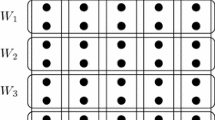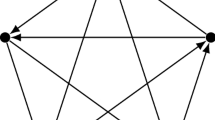Abstract
We examine all possible minimum leaves and minimum excesses for maximum group divisible packings and minimum group divisible coverings with triangles or kites, respectively. Necessary and sufficient conditions are established for their existences.
Similar content being viewed by others
References
Abel, R.J.R.: Existence of five MOLS of orders 18 and 60. J. Comb. Des. 23, 135–139 (2015)
Abel, R.J.R., Bennett, F.E., Greig, M.: PBD-closure. In: Colbourn, C.J., Dinitz, J.H. (eds.) CRC Handbook of Combinatorial Designs, pp. 247–255. CRC Press, Boca Raton (2007)
Assaf, A.: Modified group divisible designs. Ars Comb. 29, 13–20 (1990)
Bermond, J.C., Schönheim, J.: \(G\)-decomposition of \(K_n\), where \(G\) has four vertices or less. Discrete Math. 19, 113–120 (1977)
Billington, E.J., Lindner, C.C.: Maximum packings of uniform group divisible triple systems. J. Comb. Des. 4, 397–404 (1996)
Brouwer, A.E.: Optimal packings of \(K_{4}\)’s into a \(K_{n}\). J. Comb. Theory A 26, 278–297 (1979)
Chang, Y., Lo Faro, G., Tripodi, A.: Tight blocking sets in some maximum packings of \(\lambda K_n\). Discrete Math. 308, 427–438 (2008)
Chang, Y., Lo Faro, G., Tripodi, A., Zhou, J.: TBSs in some minimum coverings. Discrete Math. 313, 278–285 (2013)
Colbourn, C.J., Ling, A.C.H.: A class of partial triple systems with applications in survey sampling. Commun. Stat. Theory Methods 27, 1009–1018 (1998)
Colbourn, C.J., Ling, A.C.H.: Balanced sampling plans with block size four excluding contiguous units. Aust. J. Comb. 20, 37–46 (1999)
Dukes, P.J., Feng, T., Ling, A.C.H.: Matching divisible designs with block size four. Discrete Math. (accepted)
Fort Jr, M.K., Hedlund, G.A.: Minimum coverings of pairs by triples. Pac. J. Math. 8, 709–719 (1958)
Francetić, N., Danziger, P., Mendelsohn, E.: Group divisible covering designs with block size 4: a type of covering array with row limit. J. Comb. Des. 21, 311–341 (2013)
Ge, G., Wang, J., Wei, R.: MGDD with block size 4 and its application to sampling designs. Discrete Math. 272, 277–283 (2003)
Haggard, G.: On the function \(N(3,2,\lambda, v)\). Congr. Numer. 6, 243–250 (1972)
Hanani, H.: Balanced incomplete block designs and related designs. Discrete Math. 11, 255–369 (1975)
Heinrich, K., Yin, J.: On group divisible covering designs. Discrete Math. 202, 101–112 (1999)
Hoffman, D., Kirkpatrick, K.: \(G\)-designs of order \(n\) and index \(\lambda \) when \(G\) has \(5\) vertices or less. Aust. J. Comb. 18, 13–37 (1998)
Mendelsohn, E., Shalaby, N., Shen, H.: Nuclear designs. Ars Comb. 32, 225–238 (1991)
Spencer, J.: Maximal consistent families for triples. J. Comb. Theory Ser. A 5, 1–8 (1968)
Stanton, R.G., Rogers, M.J.: Packings and coverings by triples. Ars Comb. 13, 61–69 (1982)
Stinson, D.R.: Combinatorial Designs: Constructions and Analysis. Springer, New York (2004)
Wang, H., Chang, Y.: Kite-group divisible designs of type \(g^{t}u^{1}\). Graphs Comb. 22, 545–571 (2006)
Wang, J.: Incomplete group divisible designs with block size four. J. Comb. Des. 11, 442–455 (2003)
Wang, J., Yin, J.: Existence of holey 3-GDDs of type \((u, g^tw^1)\). Discrete Math. 202, 249–269 (1999)
Wilson, R.M.: Constructions and uses of pairwise balanced designs. Math. Centre Tracts 55, 18–41 (1974)
Yin, J.: Packing designs with equal-sized holes. J. Stat. Plan. Inference 94, 393–403 (2001)
Yin, J., Wang, J.: \((3,\lambda \))-group divisible covering designs. Aust. J. Comb. 15, 61–70 (1997)
Zhu, L.: Some recent developments on BIBDs and related designs. Discrete Math. 123, 189–214 (1993)
Author information
Authors and Affiliations
Corresponding author
Additional information
Supported by NSFC under Grants 11271042 and 11471032.
Appendices
Appendix 1: (3, 1)-MGDC of type \(5^4\) from [17]
The required (3, 1)-MGDC of type \(5^4\) is constructed on \(S \cup R\) where \(S=\{a_{ij}:1 \le i \le 3\) and \(1 \le j \le 5\}\) and \(R=\{x_j:1 \le j \le 5\}\) with \(S \cap R=\phi \). The four groups are R and \(\{a_{ij}:1\le j\le 5\}\) for \(1\le i\le 3\). All blocks are listed below.
The excess graph contains edges: \(\{x_{4},a_{14}\}\), \(\{x_{4},a_{24}\}\), \(\{x_{4},a_{34}\}\), \(\{x_{5},a_{15}\}\), \(\{x_{5},a_{25}\}\), \(\{x_{5},a_{35}\}\), \(\{x_{1},a_{11}\}\), \(\{x_{2},a_{22}\}\), \(\{x_{3},a_{33}\}\), \(\{a_{12},a_{21}\}\), \(\{a_{13},a_{31}\}\), \(\{a_{23},a_{32}\}\).
Appendix 2: (3, 1)-IGDC of type \((11,5)^4\) in Lemma 4.5
Rights and permissions
About this article
Cite this article
Hu, X., Chang, Y. & Feng, T. Group Divisible Packings and Coverings with Any Minimum Leave and Minimum Excess. Graphs and Combinatorics 32, 1423–1446 (2016). https://doi.org/10.1007/s00373-015-1644-0
Received:
Revised:
Published:
Issue Date:
DOI: https://doi.org/10.1007/s00373-015-1644-0




